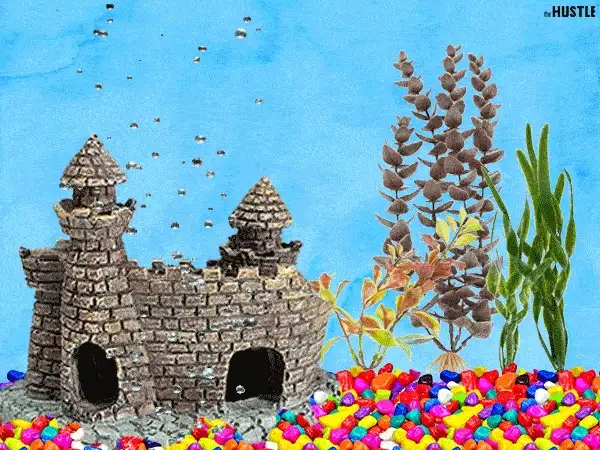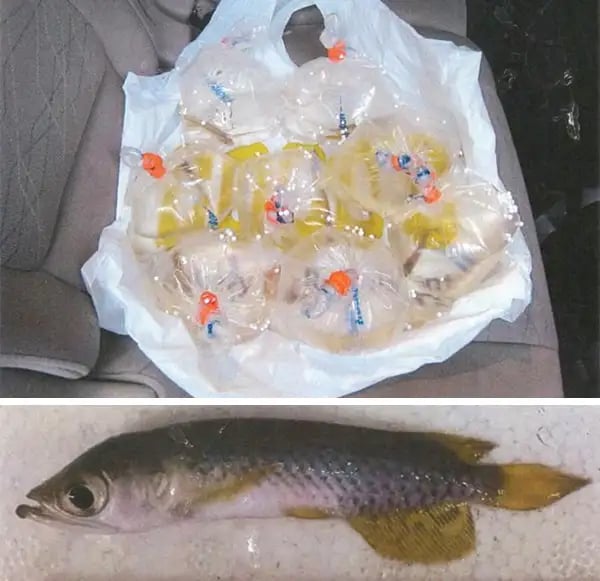On a foggy morning in February 2017, federal agents in an unmarked car pulled over a white Toyota Corolla in Orange County, California.

Guns at the ready, they cautiously approached the vehicle.
In the driver’s seat sat Shawn Lee, a 29-year-old clad in a black baseball cap. As the agents drew closer, they could see that he was cradling a large plastic bag.
Inside this bag was the subject of the manhunt. It wasn’t a brick of heroin, an illicit firearm, or a bundle of dirty money.
“What’ve you got in there?” one of the agents asked.
“Fish,” said Lee.
And not just any fish: 8 writhing Asian arowana — the world’s most valuable aquarium pet.

Asian arowana retrieved from a bust in Orange County, California, in 2017. (US Fish and Wildlife Service, via court filings)
An endangered species in the wild, the Asian arowana is illegal to import, sell, and, in most cases, own in the US.
Every now and again, tales like Lee’s will surface in the news, shedding light on a bizarro black market.
But elsewhere in the world, the fish is a highly coveted (and perfectly legal) luxury good. They’re prized by Yakuza gang members in Japan, business magnates in China, and superfish collectors in Europe — and a single prime specimen can cost more than a Ferrari.
How did this fish become such a hot commodity? Who controls the market? And why is it illegal on US soil?
How a swampy creature became swanky
For centuries, the Asian arowana was nothing more than a meal foraged from the blackwater rivers and swamps of Southeast Asia.
Aside from local markets in Malaysia, the fish wasn’t widely traded — and it certainly wasn’t desirable, or even recognizable, to most foreign aquarium enthusiasts.
Then, in 1975, everything changed.
As Southeast Asia’s wetland habitats declined, Asian arowana began to dwindle in number. CITES, a treaty that limits the trafficking of endangered wildlife, classified the Asian arowana as a threatened species.
The move was meant to ban commercial trade of the fish.
But according to Emily Voigt, who spent nearly a decade tracking down the story of the Asian arowana for her book, The Dragon Behind the Glass, it ended up having exactly the opposite effect.
“That official stamp of rarity totally backfired,” she tells The Hustle. “And it actually turned the fish into this limited edition luxury good.”

An arowana bought by Indonesian President Susilo Bambang Yudhoyono at a price of 200m rupiah ($20k USD) swims during an exhibition in Jakarta in 2008. (ADEK BERRY/AFP/Getty Images)
Malaysian smugglers began sneaking Asian arowana into Taiwan. From there, the fish found its way to Japan, where it became a Veblen good among Yakuza gang members.
In a bid to dampen this illicit trade, CITIES allowed farmers in Southeast Asia to legally breed, harvest, and sell Asian arowana. The logic was that a flood of new fish would drive down prices and make them a less desirable commodity.
But once again, things went off the deep end.
Over the ensuing decades, hundreds of arowana farms popped up throughout Indonesia and Malaysia and the fish all but disappeared from the wild.
Today, the Asian arowana’s largest market is in China.
Dubbed the “dragon fish” due to its shiny scales, long whiskers, and fierce disposition, the arowana has taken on a spiritual aura.
“It has become this mystical creature that supposedly protects you and helps you make good business decisions,”Voigt tells The Hustle. “It’s thought to bring wealth and prosperity. There are even accounts of arowana leaping out of their tanks to warn of a bad omen.”
Owners will go above and beyond to keep their fish aesthetically pleasing.
Dedicated “fish beauticians run profitable businesses performing plastic surgery on fish. In a bid to flaunt the most beautiful specimen, owners give their pets eye lifts ($90), chin jobs ($60), and tail alterations ($60).

Gong Hengliang, who has been a “fish beautician” for 4 years, performs cosmetic surgery on an Asian arowana fish in 2020 in Lanzhou, China. (Photo by Gao Zhan/China News Service via Getty Images)
This fanaticism has turned farm-bred Asian arowana (which are legal in most countries) into an estimated $200m/year global market.
The $300k fish
In the mid-1980s, an Indonesian printing executive named Tris Tanoto quit his job and bought 12 Asian Arowana for $170.
With help from friends, he bought a small farm in East Jakarta, released the fish in a pond on the property, and, through trial and error, taught himself the art of breeding.
Today, Tanoto’s operation is one of at least 250 CITES-approved Asian arowana farms across Southeast Asia, the majority of which are centered in Indonesia and Malaysia.
His company, PT Munjul Prima Utama, is one of Indonesia’s largest exporters of Asian arowana — particularly, the “Super Red,” a bright crimson varietal that is highly desirable to Chinese buyers, who view the color red as a representation of vitality and good fortune.

Scenes from Tanoto’s farm in Indonesia. (Images via Toro Tanoto)
Each year, the company sells around 1k of its 7k stock of Asian arowana, netting ~$3m USD in annual revenue.
This works out to $3k per fish on average, but prices can vary tremendously based on a variety of factors:
- Coloration: The fish can be found in red, green, gold, and silver variations. But a market has emerged for “designer-bred” colors like Red Tail Golden Splendor, Violet Fusion Super Red, and Blue Base Golden.
- Pedigree: Fish bred from earlier generations of wild-caught arowana tend to fetch higher prices.
- Fin size and head shape: Larger dorsal fins up the price.
Tanoto sells 8 varieties of Asian arowana, ranging in price from $1.2k to $5.5k. Once, he says he sold a “flawless” Super Red to a buyer in China for $30k.
Extremely rare Asian arowana can fetch up to 10x that amount.
A breeder in Malaysia who specializes in albino Asian arowana, purportedly sold one of his stock to a high-ranking member of the Chinese Communist Party for $300k.
Some of these farms are so lucrative that they’re publicly traded corporations.
In her book, Voigt tells the story of Kenny Yap (AKA, “Kenny the Fish”), a 55-year-old ex-pig farmer who — when not taking nude photos with his fish — runs Singapore’s largest arowana farm.
Yap’s company, Qian Hu, distributes fish to 80 countries, has 5 global export hubs, and is listed on the Singapore Exchange. In 2019, the firm sold ~$30m worth of fish and spawned more than 7k Asian arowana. (You can take a peek at their annual report here.)

Kenny Yap takes dip with his arowana (Qian Hu)
This potential for big paydays makes the trade extremely competitive — and often dangerous — for farm owners like the Tanotos.
“Competition is fierce and very unhealthy,” Tris’ son and business partner, Toro, tells The Hustle via email. “There have been a lot of frauds using our company’s name, both locally and globally. They pretend to be us and send fake Arowana photos to global customers on social media.”
Voigt says it’s not uncommon to hear tales of arowana-related sabotage, theft, and even murder. She calls the fish “an agent of chaos.”
In 2004, a Malaysian shop owner was killed by thieves who were after his trove of 20+ Asian arowana. Armed robberies are frequent — and breeders often secure their lots with concrete walls, barbed wire, watch towers, and dogs.
Some farms also run elaborate international Ponzi schemes, selling the same fish to multiple clients around the globe.
The supply chain
Rather than go directly to customers, many farms in Southeast Asia sell in bulk to dealers in other countries.
Among these dealers is David Carr, who runs Planet Arowana, a 100-tank specialty fish shop in London.

A visitor snaps a shot of the a prize-winning arowana at Singapore’s Aquarama, the largest trade show for exotic fish enthusiasts. (ROSLAN RAHMAN/AFP via Getty Images)
Carr, a 41-year-old ex-chef, first got into fish at 17. What began with guppies in a small glass bowl soon evolved into a school of African Cichlids in an 8-foot tank.
One day, he asked himself: “What is the most prestigious, most sought-after, most beautiful fish on the planet?”
“I learned about the Asian arowana and became obsessed,” he says. “There’s nothing else like it. It’s the majestic dragon.”
The Londoner moved to Malaysia, where he spent a year learning everything he could about the fish from local breeders. While there, he set up his own 55’x30’ pond with investors.
The process, he says, works like so:
- The pond is filled with 20 arowana (6 males, 14 females).
- At around 3 years of age, the fish “get jiggy.” Each female produces between 10-80 eggs.
- Every 2-3 months, baby fish (called fingerlings) are harvested.
- The fish are shipped to the UK and sold at ~4-6 months of age for between $300 and $4k+ each.
In captivity, Asian arowana can live for 25+ years, making the recurring cycle appealing to investors.
“It can be very lucrative if you do it right,” Carr told us. “People who invest $50k-$100k in Asian arowana ponds definitely get their return back.”
Carr sells his arowana to buyers all over the world. In recent years, he says demand has expanded from Asia to the Western world.
“As soon as someone sees the Asian arowana, they fall in love,” he says. “When aquarists want one belter of a fish — the crème de la crème — they [trade] up and get one.”

A few Asian arowana color variations: Super Red, 24k Gold, and Platinum. (Collage, via photos from Getty Images)
Glen Mickle, a 32-year-old carpenter who lives in Alberta, Canada, where Asian arowana are legal, got into the fish 6 years ago at a local auction.
He started out with an $800 Blue Base Golden Crossback which he named “Einstein.” Six months later, he splurged on a Super Red for $1k, then another, imported from Indonesia, for $1.7k.
“They’re my prizes,” he says of the fish.
Mickle created United Arowana, a private Facebook group for “arowana lovers” that boasts ~19k members. The community is one of many hubs — including the forums Arofanatics and Monster Fish Keepers — where Asian arowana enthusiasts talk shop.
One topic comes up particularly often: The illegal nature of the fish in the United States.
The black market
While Asian arowana are legally bought and sold in most international markets, buying and selling them is strictly prohibited in the US under the Endangered Species Act.
But that hasn’t stopped Americans — or breeders in Asia — from attempting to create their own underground fish pipeline.
“I know about 10 people in the US who own Asian arowana,” Mickle told us. “I would say it’s a lot more common than people think. It’s just not [talked about] as much, for obvious reasons.”

The Hustle
The Fish and Wildlife Service has commandeered no shortage of Asian arowana busts over the past decade:
- In 2010, 7 people were arrested in Los Angeles for attempting to smuggle in 12 juvenile Asian arowana from Indonesia.
- In 2011, a 49-year-old Chinese food delivery driver was caught trying to import 16 fish from Malaysia to NYC in a suitcase.
- In 2014, two men in San Diego were caught with 13 of the fish, which they were trying to sell on Craigslist for $2.8k each.
- In 2018, a Chicago chef was busted for trying to buy 24 Asian arowana for his home aquarium.
Most often, perpetrators receive a sentence of probation and fines of between $5k and $15k — a small fee to pay for the potential upside of such underground operations.
In one case, a smuggler paid a Vietnamese farmer $6.6k for 16 Asian arowana ($412 each) and sold for them in the US for $1.9k a pop — a profit margin of 78%.
Setting up a deal like this requires secretive communication between smugglers in Southeast Asia and buyers in the US.
Both parties are well aware of the high stakes.
A transaction between Shawn Lee (a 29-year-old from Garden Grove, California) and Mickey Tanadi (a breeder from Jakarta, Indonesia) began with the following exchange over an international texting app:

A recreation of exact texts exchanged between Lee (blue) and Tanadi (gray) in 2017, via US District Court filings (The Hustle)
Lee sent Tanadi a wire transfer for $2,550.
In turn, Tanadi secured 8 Asian arowana in water-filled plastic bags hidden inside ceramic pots. He shipped them to the US via DHL with a final text that may as well have been addressed to the fish themselves:
“…Don’t get caught.”
